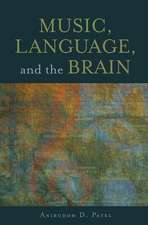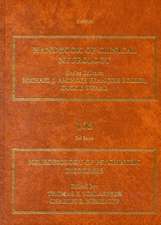Breathing, Emotion and Evolution: Progress in Brain Research, cartea 212
Gert Holstege, Caroline M. Beers, Hari H. Subramanianen Limba Engleză Hardback – 9 sep 2014
- This well-established international series examines major areas of basic and clinical research within neuroscience, as well as emerging subfields.
Din seria Progress in Brain Research
- 9%
 Preț: 1159.33 lei
Preț: 1159.33 lei - 39%
 Preț: 1230.29 lei
Preț: 1230.29 lei - 9%
 Preț: 1232.44 lei
Preț: 1232.44 lei - 9%
 Preț: 1232.44 lei
Preț: 1232.44 lei - 5%
 Preț: 1281.30 lei
Preț: 1281.30 lei - 9%
 Preț: 1226.58 lei
Preț: 1226.58 lei - 5%
 Preț: 1281.42 lei
Preț: 1281.42 lei - 9%
 Preț: 1229.83 lei
Preț: 1229.83 lei - 9%
 Preț: 1232.44 lei
Preț: 1232.44 lei - 9%
 Preț: 1226.78 lei
Preț: 1226.78 lei - 32%
 Preț: 1228.99 lei
Preț: 1228.99 lei - 32%
 Preț: 1233.29 lei
Preț: 1233.29 lei - 29%
 Preț: 1283.57 lei
Preț: 1283.57 lei - 29%
 Preț: 1215.87 lei
Preț: 1215.87 lei - 32%
 Preț: 1154.95 lei
Preț: 1154.95 lei - 9%
 Preț: 1154.27 lei
Preț: 1154.27 lei - 9%
 Preț: 1151.54 lei
Preț: 1151.54 lei - 9%
 Preț: 1164.52 lei
Preț: 1164.52 lei - 9%
 Preț: 1160.07 lei
Preț: 1160.07 lei - 5%
 Preț: 2050.37 lei
Preț: 2050.37 lei - 5%
 Preț: 1207.95 lei
Preț: 1207.95 lei - 32%
 Preț: 1161.07 lei
Preț: 1161.07 lei - 32%
 Preț: 1157.18 lei
Preț: 1157.18 lei - 5%
 Preț: 2062.98 lei
Preț: 2062.98 lei - 9%
 Preț: 1155.98 lei
Preț: 1155.98 lei - 9%
 Preț: 1164.43 lei
Preț: 1164.43 lei - 9%
 Preț: 1158.65 lei
Preț: 1158.65 lei - 9%
 Preț: 1164.50 lei
Preț: 1164.50 lei - 9%
 Preț: 1149.16 lei
Preț: 1149.16 lei - 9%
 Preț: 1159.43 lei
Preț: 1159.43 lei - 5%
 Preț: 1214.52 lei
Preț: 1214.52 lei - 9%
 Preț: 1153.55 lei
Preț: 1153.55 lei - 9%
 Preț: 1156.91 lei
Preț: 1156.91 lei - 9%
 Preț: 1156.05 lei
Preț: 1156.05 lei - 9%
 Preț: 1159.50 lei
Preț: 1159.50 lei - 9%
 Preț: 1156.91 lei
Preț: 1156.91 lei - 5%
 Preț: 1205.96 lei
Preț: 1205.96 lei - 9%
 Preț: 1161.24 lei
Preț: 1161.24 lei - 41%
 Preț: 1084.00 lei
Preț: 1084.00 lei - 9%
 Preț: 1221.36 lei
Preț: 1221.36 lei - 29%
 Preț: 1212.66 lei
Preț: 1212.66 lei
Preț: 1164.43 lei
Preț vechi: 1279.59 lei
-9% Nou
Puncte Express: 1747
Preț estimativ în valută:
222.86€ • 231.77$ • 186.49£
222.86€ • 231.77$ • 186.49£
Carte tipărită la comandă
Livrare economică 07-21 martie
Preluare comenzi: 021 569.72.76
Specificații
ISBN-13: 9780444634887
ISBN-10: 0444634886
Pagini: 422
Dimensiuni: 191 x 235 x 28 mm
Greutate: 1.23 kg
Editura: ELSEVIER SCIENCE
Seria Progress in Brain Research
ISBN-10: 0444634886
Pagini: 422
Dimensiuni: 191 x 235 x 28 mm
Greutate: 1.23 kg
Editura: ELSEVIER SCIENCE
Seria Progress in Brain Research
Public țintă
This volume not only provides essential information for neuroscientists involved in respiration research, but also for clinicians treating patients with respiratory problems.Cuprins
- Physiological and Pathophysiological Interactions between the Respiratory Central Pattern Generator and the Sympathetic Nervous System
- Coupling of Respiratory and Sympathetic Activities in Rats Submitted to Chronic Intermittent Hypoxia
- Function and Modulation of Premotor Brainstem Parasympathetic Cardiac Neurons that Control Heart Rate by Hypoxia, Sleep, and Sleep Related Diseases Including Obstructive Sleep Apnea
- Discharge Properties of Upper Airway Motor Units during Wakefulness and Sleep
- Effects of Calcium (Ca2+) Extrusion Mechanisms on Electrophysiological Properties in a Hypoglossal Motoneuron (HM): Insight from a Mathematical Model
- Using a Computational Model to Analyze the Effects of Firing Frequency on Synchrony of a Network of Gap Junction-Coupled Hypoglossal Motoneurons (HMs)
- The Physiological Significance of Postinspiration in Respiratory Control
- Expiration: Breathing’s Other Face
- The Effects of Head-Up and Head-Down Tilt on Central Respiratory Chemoreflex Loop Gain Tested by Hyperoxic Rebreathing
- The Challenges of Respiratory Motor System Recovery following Cervical Spinal Cord Injury
- Intermittent Hypoxia-Induced Respiratory Long-Term Facilitation is Dominated by Enhanced Burst Frequency, not Amplitude, in Spontaneously Breathing Urethane-Anesthetized Neonatal Rats
- Chronic Nitric Oxide Synthase Inhibition does not Impair Upper Airway Muscle Adaptation to Chronic Intermittent Hypoxia in the Rat
- The Generation of Pharyngeal Phase of Swallow and its Coordination with Breathing: Interaction between the Swallow and Respiratory Central Pattern Generators
- Control of Coughing by Medullary Raphé
- The Respiratory-Vocal System of Songbirds: Anatomy, Physiology and Neural Control
- The Lamprey Blueprint of the Mammalian Nervous System
- The Midbrain Periaqueductal Gray Changes the Eupneic Respiratory Rhythm into a Breathing Pattern Necessary for Survival of the Individual and of the Species








